Roused by the wooden 'bells' at 4.00 a.m., we saw the monks taking breakfast and performing their ablutions.
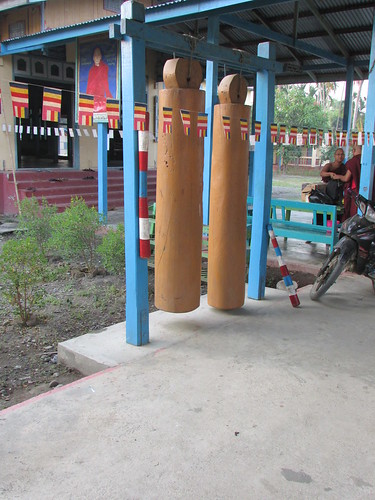
Sel-Taw-Oo Monastery: The wooden 'bells' which announce the start of the monastic day: 30th April 2018
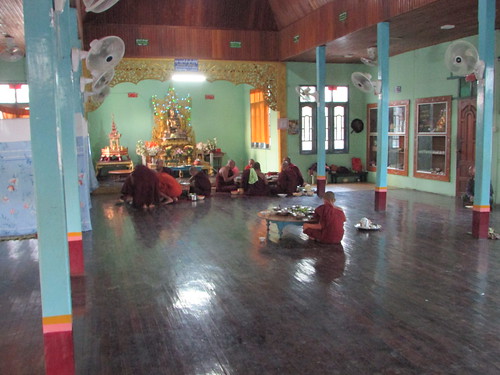
Sel-Taw-Oo Monastery: Monks taking breakfast. The curtained area on the left was our sleeping quarters: 30th April 2018
Befire we left Sel-Taw-Oo Monastery, we looked at the local rice mill. This was a delightful 'Heath-Robinson' affair and it will take me a while to understand the pictures I took. Outside the mill itself, there was a huge pile of rice husks. Even these can be used as a fuel, instead of wood.
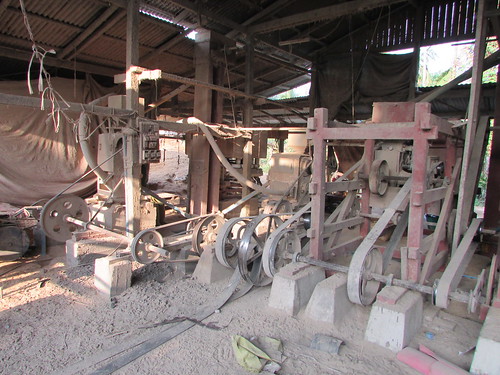
Sel-Taw-Oo Rice Mill: 30th April 2018
Then we headed along a minor road through paddy fields of mainly sunflower. In 2015 unusually heavy rain caused serious flooding and many villagers had to evacuate to higher ground. The Doctor said the aftermath was 7 feet of mud which damaged crop growth.
We passed through a number of villages, each with a Christian church. Many of the Chin people are Baptist (of one or other of the many ‘flavours’ of this denomination). Eventually, we came to the main road into Kalay and stopped at a Tea Shop where various items of pastry were being prepared in woks or griddles, all wood fired. I thought that this was one of the cleanest tea shops I’d seen in Myanmar and we took breakfast here.
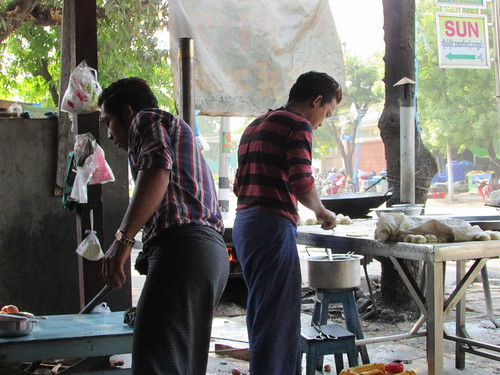 Breakfast in preparation at a Kalay Tea Shop: 30th April 2018
Breakfast in preparation at a Kalay Tea Shop: 30th April 2018
Having stopped in Kalay for petrol we then met up with a charming lady, Hlaing Hlaing Htay, her husband Ko Thein Shwe and her children who were waiting in their pick-up for us to pass. Everybody we met was a friend or relative of our Monk from Bagan, but I wasn't able to sort out the details. In convoy, our car and the pick-up took a left turn onto the mountain road which generally heads west. When we were a few hundred feet above the plain on which Kalay is built, we stopped at a viewpoint. I was fascinated by all the memorials there, partly because they were all Christian, partly because, although there were fragments of English, most were written in the Chin language which uses the Roman alphabet, rather than the characters used to write the Myanmar language.
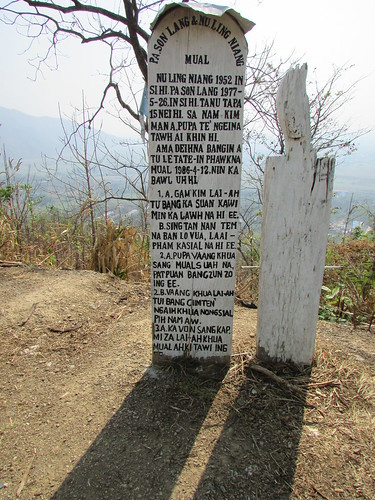
Memorials in the Chin language, overlooking the plain.
Our route then continued into the mountains. Sometimes the road followed the contours of the hills, snaking left and right, sometimes machines had cut a ledge for the road where the mountainside was too steep. As well as twisting left and right, we were often going downhill but the overall trend was upwards, upwards.
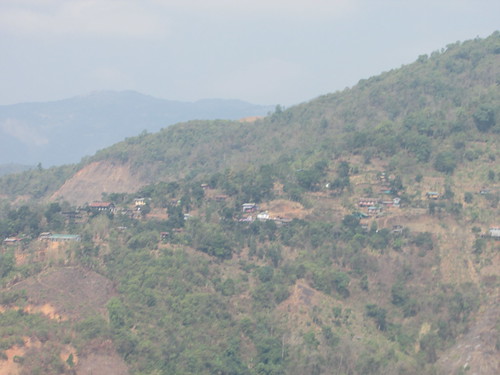
Visit to Chin State 30th April 2018: The road we were on threaded its way through the mountains.
There were frequent signs of the road improvement programme being provided by the Japanese organisation J.I.C.A. under its friendship programme. Since there was normally a precipitous drop on one side of the road and a rock face on the other, modern 'Armco' style barriers had been installed on the side with the drop, periodically fitted with coloured metal markers, red on one side, yellow on the other. The rock face showed the signs of having be shaped by a large excavator. Sometimes a retaining wall had been built, extending upwards from the roadway and there was often a substantial concrete channel to run water downhill to the nearest natural channel running down the mountain side. Each channel was culverted to cross the roadway, necessitating retaining walls on both sides of the roadway.
We passed a number of villages. Their approach was heralded by coming across large woodpiles neatly stacked at the roadside. The buildings themselves were generally of a different style - wooden-framed, clad with horizontal planks and sometimes windowless. The ubiquitous 'tin roof' of galvanised corrugated iron sheeting provided a durable roof. This was a design adapted for the much lower temperatures encountered at higher altitudes, and remined me of parts of Tibet. The Chin people, too, differed in appearance from the typical Burmese, being darker-skinned and often with a rather fierce appearance.
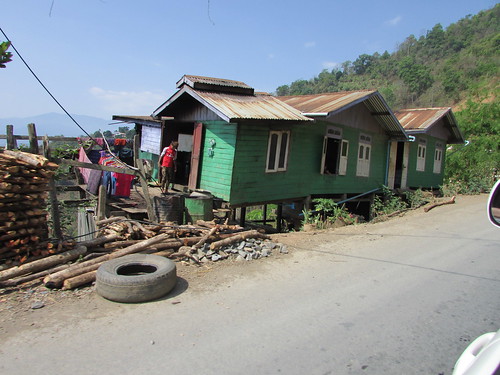
Visit to Chin State 30th April 2018: Typical wooden housing, built on wooden piles on the mountain side, with the woodpile on the left.
Then, we stopped at the end of a queue of waiting vehicles. Up ahead, I could see a large excavator gouging the cliff face and blocking the road with mounds of stone in the process. Apparently, the roadbuilders are given 30 minute 'slots' to work on gouging the cliff face. Next, loading shovels clear a path through the excavated rock for vehicles then finally one-way traffic is instituted over the narrowed section. While we were waiting, the Doctor chatted to a group of male and female roadbuilders laying rocks to widen the carriageway.
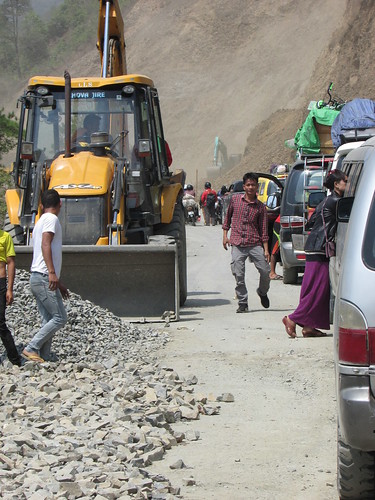
Visit to Chin State 30th April 2018: An enforced wait as a blue-painted excavator gouges the mountain side during road improvements.
Eventually, we were let through and we continued until 11.30 a.m. when we stopped so that the monk could eat his second, and last meal of the day, which had been pre-prepared and packed in metal multi-section food containers and a plastic basket. The family from the pick-up squatted on the ground nearby to eat their picnic.
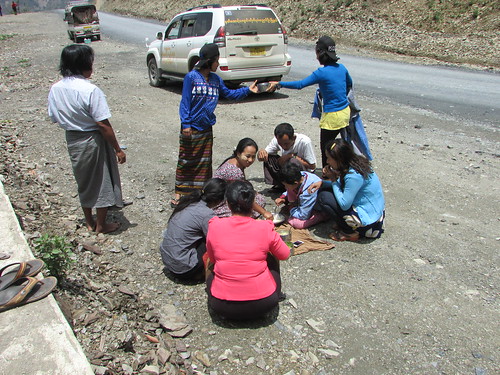
Visit to Chin State 30th April 2018: A roadside packed lunch high in the mountains.
When we reached Tedim, our elevation was 5,600 feet above sea level so we made a photographic stop at a viewpoint next to a petrol station.
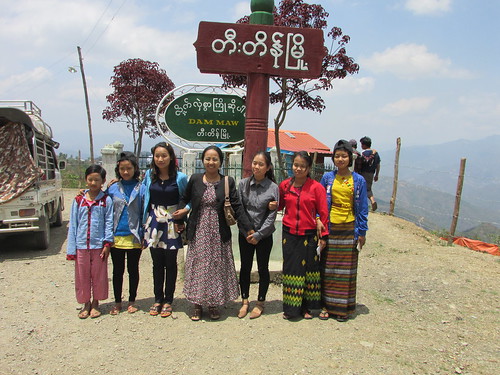
Hlaing Hlaing Htay and her children at Tedim.
We continued but the tarmac road soon gave way to graded and rolled rock and the ride wbecame significantly less comfortable. After a while there were signs of problems with our vehicle and each bump in the road triggered a slow up and down motion which could throw passengers quite violently around. We stopped and a failed suspension air bag was diagnosed but we were in a remote location so there was no alternative to carrying on although nobody enjoyed it. I ended the day was in a fairly bad way, aching and bruised.
We crossed a river on an imposing yellow-painted suspension bridge and eventually came to Rihkhawdar where a rusty truss bridge on a side road led to the other side of the river, which is in India. Our journey from Kalay had been around 119 km.
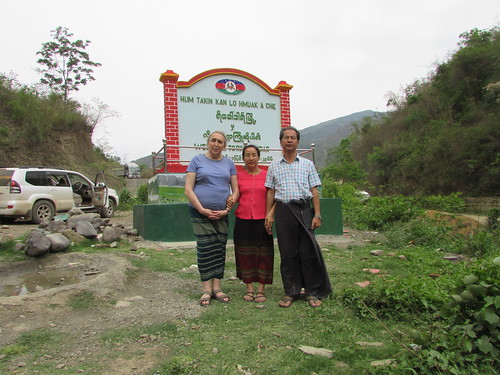
Visit to Chin State 30th April 2018: Doctor Hla Tun, his wife and Jan on arrival at Rihkhawdar.
We paid a brief visit to a small monastery but as there were no monks present, our visit was confined to talking to a group of men working around the monastery garage. Our final destination for the day was a few miles away at a small, pretty lake called Rith Lake. There was a cafe and a number of chalets.
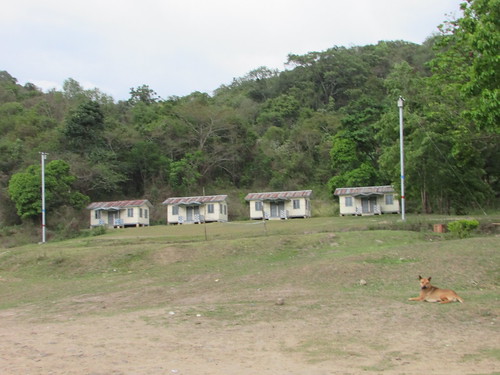
Visit to Chin State 30th April 2018: The chalets overlooking Rith Lake.
Apparently, with the border so near, it's a popular spot for Indian tourists. The Doctor secured two rooms, one for me and one for himself and his wife. Later the pick-up arrived so there was an extensive picture-taking session. The chalets themselves were typical guest house standard with wooden beds and a hard mattresses about 30 m.m. thick. A small extension at the rear of each chalet featured a Western-style flush toilet, although washing facilities were confined to the usual large plastic bucket which the guest re-filled as required from a cold water tap mounted above. After a meal in the cafe, the owner started his petrol electric generator so there were electric lights and I was able to re-charge my various electrical items. I was very content.
Related posts on this website
This is one of a series of posts describing my 13th visit to Myanmar.
The post Travelling again is the first post in the series.
Clicking on the 'Next report' link will show the post describing the next events. In this way, you may read about the trip in sequence.
Next report
Alternately, clicking on the 'All my Burma-2018 reports' link displays all the posts on this trip in reverse date-of-posting order.
All my Burma-2018 reports
My pictures
Visit to Chin State 30th April 2018
All my pictures on this trip to Myanmar can be found at Burma 2018.
[Pictures linked 10-May-2018, pictures inserted 31-May-2018, minor changes and more pictures inserted 7-Jun-2018]
